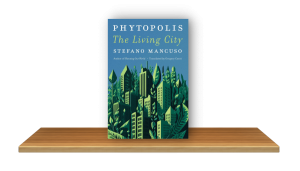Gregory Conti on Phytopolis, by Stefano Mancuso
In this latest book by Italy’s best-known botanist, Stefano Mancuso speaks to his readers where the vast majority of them live, in cities. More and more, and the summer of 2024 is only the most recent and to date most extreme example, that means cities that are so overheated they are at risk of becoming unlivable. Right now, 55% of the world’s population lives in cities; by 2070 70% of us will live there, and as I’m sure you have noticed, our cities are getting hotter. Now, 14% of the urban population experiences intense summer heat. By 2050 the share of the overheated urban population is predicted to reach 45%. Put another way, by 2080, as we are now trending, your city will have the climate of a city almost 500 miles to the south.

So there is no doubt, overheated cities are a serious problem. But I don’t want to give you the wrong impression. Actually, two wrong impressions. Though it is rich in scientific references and information, Phytopolis, like all of Mancuso’s books, is much more than that. More important, the optimism expressed in the subtitle, The Living City, is something Mancuso takes, and wants his readers to take, to heart. Phytopolis describes and explains the problem of urban warming, but it also suggests and describes solutions, some of which have already been tried and are working.
If you know some of Mancuso’s previous books, you will not be surprised that the biggest contribution to solving urban warming will come from plants, particularly trees. From the prologue:
The cities of the future, whether constructed ex novo or renewed, will have to bring nature back inside our new habitat, transforming cities into phytopolises (phyto, or plant + polis, or city), living cities in which the relationship between plants and animals approaches the relationship that we find in nature: 86.7 percent plants and 0.3 percent animals (humans included). This would involve dedicating a large part of the surface area of a city to plants, which is the exact opposite of what happens today. I can’t think of anything more important than this for the future of humanity: recalibrating our relationships with the other living beings, first among them our relationship with plants.
Mancuso cites the examples of Paris, Berlin and especially Seoul, with its more than 16 million new trees, as cities that have already put into place programs to bring nature back into the city. In chapter nine of the book, “Treeways,” he tells of the Brazilian city of Curitiba, population 2 million, which in just a few years has increased its green space from 10.7 square feet to 592 square feet per person by planting millions of trees and creating dozens of parks, but also by turning its main traffic street into a treeway, where cars have been replaced by bicycles and pedestrians, and by adding an efficient rapid transit system.
The real beauty of Phytopolis, however, is much broader and more profound than these encouraging and useful examples. This short and engaging book is most significant for its presentation of how we got to where we are today. Our largely nature-free cities, Mancuso explains, have come about because humans have modeled cities on our own bodies and without reference to or understanding of the living beings that have been the most successful species in adapting to their environment: plants. In chapters that provide a basic overview of the human-based models of urban planning, from the Renaissance to Le Corbusier and Robert Moses, Mancuso offers us a new understanding of our relationship with nature, which we are part of and not separate from and superior to. If we want to make living cities, Mancuso suggests, we must reach a new understanding of how cities, like all living beings, evolve, and how we can learn from plants in adapting to and modifying our environment to ensure our survival and our happiness.
In conclusion, I should note that the publication date chosen by Mancuso’s American publisher, Other Press, is no accident. Like his three previous books published by OP, Phytopolis will be coming out on Earth Day and I can’t think of any better way to celebrate than by reading it, unless perhaps you want to start by reading the others, all published by Other Press and translated by Gregory Conti.
Gregory Conti – Born and raised in Pittsburgh, he moved to Perugia in 1985. Since then he has taught at the University of Siena (Arezzo), the University of Perugia, Rutgers University, and the University of Rochester (Arezzo). His published translations include works by Giuseppe Berto, Rosetta Loy, Emilio Lussu, Paolo Rumiz, and Stefano Mancuso. He is currently working on a collection of short stories by Leonardo Sciascia and The Jews in Italy by Anna Foa.
